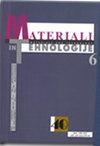EFFECT OF STEEL’S THERMAL CONDITION ON THE TRANSFORMATION TEMPERATURES OF TWO HOT-WORK TOOL STEELS WITH INCREASED THERMAL CONDUCTIVITY
IF 0.8
4区 材料科学
Q4 MATERIALS SCIENCE, MULTIDISCIPLINARY
引用次数: 0
Abstract
The aim of our study was to investigate how different thermal conditions affect the transformation temperatures of two hot-work steels with high thermal conductivity. We focused on two conditions: soft annealing, and quenching and tempering. Soft annealing results in a ferritic steel matrix with spherical carbides, while quenching and tempering result in a fully hardened and tempered martensitic matrix with secondary and tempering carbides. We analysed samples using a simultaneous thermal analysis (STA) and differential scanning calorimetry (DSC) to determine the transformation temperatures. Controlled heating and cooling allowed us to observe the energy changes associated with the phase transformations. The equilibrium temperatures were calculated using the CALPHAD method. Our study investigated the influence of thermal conditions on different transformation temperatures, including solidus/liquidus temperatures, austenite solid transformation temperatures (A1 and A3), austenite solidification temperatures and bainite and/or martensite transformation temperatures. A DSC analysis was used to quantitatively measure the transformation temperatures and energy absorption during the endothermic processes (austenite solid transformation and melting) and to study the energy release during the exothermic processes (solidification and transformation). The results showed that soft annealing reduced the solidification interval and the solidus temperature, while energy absorption increased during melting. Conversely, quenching and tempering reduced the austenite solid transformation temperatures and energy release during solidification, including δ-ferrite solidification.钢的热状态对两种导热系数增加的热作工具钢转化温度的影响
我们的研究旨在探讨不同的热处理条件如何影响两种高导热性热作钢的转化温度。我们重点研究了两种条件:软退火以及淬火和回火。软退火的结果是铁素体钢基体出现球状碳化物,而淬火和回火的结果是完全硬化和回火的马氏体基体出现二次碳化物和回火碳化物。我们使用同步热分析(STA)和差示扫描量热仪(DSC)对样品进行分析,以确定转变温度。通过控制加热和冷却,我们可以观察到与相变相关的能量变化。平衡温度是通过 CALPHAD 方法计算得出的。我们的研究调查了热条件对不同转变温度的影响,包括固/液温度、奥氏体固态转变温度(A1 和 A3)、奥氏体凝固温度以及贝氏体和/或马氏体转变温度。DSC 分析用于定量测量内热过程(奥氏体固态转变和熔化)中的转变温度和能量吸收,并研究放热过程(凝固和转变)中的能量释放。结果表明,软退火缩短了凝固间隔和凝固温度,而熔化过程中的能量吸收则有所增加。相反,淬火和回火降低了奥氏体固态转变温度和凝固过程中的能量释放,包括δ-铁素体凝固。
本文章由计算机程序翻译,如有差异,请以英文原文为准。
求助全文
约1分钟内获得全文
求助全文
来源期刊

Materiali in tehnologije
工程技术-材料科学:综合
CiteScore
1.30
自引率
0.00%
发文量
73
审稿时长
4-8 weeks
期刊介绍:
The journal MATERIALI IN TEHNOLOGIJE/MATERIALS AND TECHNOLOGY is a scientific journal, devoted to original papers and review scientific papers concerned with the areas of fundamental and applied science and technology. Topics of particular interest include metallic materials, inorganic materials, polymers, vacuum technique and lately nanomaterials.
 求助内容:
求助内容: 应助结果提醒方式:
应助结果提醒方式:


